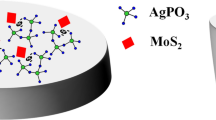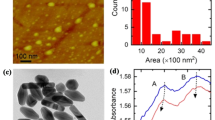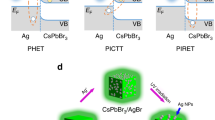Abstract
Heterostructures constructed by noble metals and two-dimensional (2D) semiconductors offer a unique charge transport path to collect hot carriers from plasmonic nanostructures and thus are promising for various plasmonic and optoelectronic devices. However, the desired charge transfer speed and efficiency of the conventional heterostructures are usually restricted by the limited interface area and inevitable interface distortion and contamination. Herein, we report the ultrafast and high-efficiency hot electron transfer by creating a novel Au@MoS2 core-shell heterostructure with atomically sharp and dramatically enlarged interface. Our femtosecond transient absorption spectroscopy study indicates the hot-electron injection from Au nanoparticles to MoS2 in Au@MoS2 is within 244 fs, compared with the 493 fs of the mechanically-transferred Au/MoS2 control sample. And meanwhile, the injection efficiency is improved from 3.33% of Au/MoS2 to 25.3% of our Au@MoS2. The results are further proved by Kelvin probe force microscopy and discrete dipolar approximation studies, which provide strong evidences that the improved charge transfer is attributed to the atomic-level clean and fully-encapsulated interface of the product. This study provides fundamental understanding of the intrinsic charge transfer within Au@MoS2 heterostructures and thus demonstrates an intriguing material geometry for future plasmonic and optoelectronic devices.

摘要
贵金属和二维半导体构建的异质结为等离激元纳米结构产生的热载流子提供了独特的电荷传输路径, 有望应用于各种等离激元和光电子器件. 然而, 传统异质结构的电荷转移速度和效率通常受限于有限的界面面积和不可避免的界面污染. 本文中, 具有原子级清洁和较大接触界面的新型Au@MoS2核壳异质结构能够实现超快和高效的热电子转移. 飞秒瞬态吸收光谱研究表明, Au@MoS2中从金纳米颗粒到MoS2的热电子注入时间常数小于244 fs, 而机械转移方法制备的Au/MoS2对照样品的热电子注入时间常数为493 fs, 同时, 电荷转移效率从Au/MoS2的3.33%提升至Au@MoS2的25.3%. 开尔文探针力显微镜和离散偶极近似研究进一步证明了上述结果, 明显改善的电荷转移归因于原子级清洁和完全封装的异质结界面. 这项研究提供了贵金属-二维半导体异质结构内固有电荷转移的基本理解, 从而展现了Au@MoS2这一新型异质结结构在等离激元和光电子器件中的应用前景.
Similar content being viewed by others
References
Lin WH, Wu PC, Akbari H, et al. Electrically tunable and dramatically enhanced valley-polarized emission of monolayer WS2 at room temperature with plasmonic archimedes spiral nanostructures. Adv Mater, 2022, 34: 2104863
Liu J, Zhang J. Nanointerface chemistry: Lattice-mismatch-directed synthesis and application of hybrid nanocrystals. Chem Rev, 2020, 120: 2123–2170
Linic S, Chavez S, Elias R. Flow and extraction of energy and charge carriers in hybrid plasmonic nanostructures. Nat Mater, 2021, 20: 916–924
Zhang Y, Guo W, Zhang Y, et al. Plasmonic photoelectrochemistry: In view of hot carriers. Adv Mater, 2021, 33: 2006654
Cheruvathoor Poulose A, Zoppellaro G, Konidakis I, et al. Fast and selective reduction of nitroarenes under visible light with an earth-abundant plasmonic photocatalyst. Nat Nanotechnol, 2022, 17: 485–492
You J, Yu Y, Cai K, et al. Enhancement of MoTe2 near-infrared absorption with gold hollow nanorods for photodetection. Nano Res, 2020, 13: 1636–1643
Jiang X, Huang J, Bi Z, et al. Plasmonic active “hot spots”-confined photocatalytic CO2 reduction with high selectivity for CH4 production. Adv Mater, 2022, 34: 2109330
Shao T, Wang X, Dong H, et al. A stacked plasmonic metamaterial with strong localized electric field enables highly efficient broadband light-driven CO2 hydrogenation. Adv Mater, 2022, 34: 2202367
Pi L, Wang P, Liang SJ, et al. Broadband convolutional processing using band-alignment-tunable heterostructures. Nat Electron, 2022, 5: 248–254
Clavero C. Plasmon-induced hot-electron generation at nanoparticle/metal-oxide interfaces for photovoltaic and photocatalytic devices. Nat Photon, 2014, 8: 95–103
Brongersma ML, Halas NJ, Nordlander P. Plasmon-induced hot carrier science and technology. Nat Nanotech, 2015, 10: 25–34
Kim L, Kim S, Jha PK, et al. Mid-infrared radiative emission from bright hot plasmons in graphene. Nat Mater, 2021, 20: 805–811
Wang S, Gao Y, Miao S, et al. Positioning the water oxidation reaction sites in plasmonic photocatalysts. J Am Chem Soc, 2017, 139: 11771–11778
van Turnhout L, Hattori Y, Meng J, et al. Direct observation of a plasmon-induced hot electron flow in a multimetallic nanostructure. Nano Lett, 2020, 20: 8220–8228
Camargo FVA, Ben-Shahar Y, Nagahara T, et al. Visualizing ultrafast electron transfer processes in semiconductor-metal hybrid nanoparticles: Toward excitonic-plasmonic light harvesting. Nano Lett, 2021, 21: 1461–1468
Knight MW, Sobhani H, Nordlander P, et al. Photodetection with active optical antennas. Science, 2011, 332: 702–704
Liu W, Lee B, Naylor CH, et al. Strong exciton-plasmon coupling in MoS2 coupled with plasmonic lattice. Nano Lett, 2016, 16: 1262–1269
Shan H, Yu Y, Wang X, et al. Direct observation of ultrafast plasmonic hot electron transfer in the strong coupling regime. Light Sci Appl, 2019, 8: 9
Yu Y, Ji Z, Zu S, et al. Ultrafast plasmonic hot electron transfer in Au nanoantenna/MoS2 heterostructures. Adv Funct Mater, 2016, 26: 6394–6401
Bang S, Duong NT, Lee J, et al. Augmented quantum yield of a 2D monolayer photodetector by surface plasmon coupling. Nano Lett, 2018, 18: 2316–2323
Ahn S, Kim G, Nayak PK, et al. Prevention of transition metal dichalcogenide photodegradation by encapsulation with h-BN layers. ACS Nano, 2016, 10: 8973–8979
Liu K, Jin B, Han W, et al. A wafer-scale van der Waals dielectric made from an inorganic molecular crystal film. Nat Electron, 2021, 4: 906–913
Liu Y, Gong T, Zheng Y, et al. Ultra-sensitive and plasmon-tunable graphene photodetectors for micro-spectrometry. Nanoscale, 2018, 10: 20013–20019
Li Y, Hao S, DiStefano JG, et al. Site-specific positioning and patterning of MoS2 monolayers: The role of Au seeding. ACS Nano, 2018, 12: 8970–8976
Li Y, Cain JD, Hanson ED, et al. Au@MoS2 core-shell heterostructures with strong light-matter interactions. Nano Lett, 2016, 16: 7696–7702
Lee YH, Zhang XQ, Zhang W, et al. Synthesis of large-area MoS2 atomic layers with chemical vapor deposition. Adv Mater, 2012, 24: 2320–2325
Li H, Zhang Q, Yap CCR, et al. From bulk to monolayer MoS2: Evolution of Raman scattering. Adv Funct Mater, 2012, 22: 1385–1390
Rahaman M, Rodriguez RD, Plechinger G, et al. Highly localized strain in a MoS2/Au heterostructure revealed by tip-enhanced Raman spectroscopy. Nano Lett, 2017, 17: 6027–6033
Singh MP, Strouse GF. Involvement of the LSPR spectral overlap for energy transfer between a dye and Au nanoparticle. J Am Chem Soc, 2010, 132: 9383–9391
Steinhoff A, Kim JH, Jahnke F, et al. Efficient excitonic photoluminescence in direct and indirect band gap monolayer MoS2. Nano Lett, 2015, 15: 6841–6847
Sriram P, Manikandan A, Chuang FC, et al. Hybridizing plasmonic materials with 2D-transition metal dichalcogenides toward functional applications. Small, 2020, 16: 1904271
Zheng Z, Wang X, Shen Y, et al. Space-confined synthesis of 2D all-inorganic CsPbI3 perovskite nanosheets for multiphoton-pumped lasing. Adv Opt Mater, 2018, 6: 1800879
Li Y, Shi J, Chen H, et al. Slow cooling of high-energy C excitons is limited by intervalley-transfer in monolayer MoS2. Laser Photonics Rev, 2019, 13: 1800270
Zhou D, Li X, Zhou Q, et al. Infrared driven hot electron generation and transfer from non-noble metal plasmonic nanocrystals. Nat Commun, 2020, 11: 2944
Liu Y, Chen Q, Cullen DA, et al. Efficient hot electron transfer from small Au nanoparticles. Nano Lett, 2020, 20: 4322–4329
Ran M, Zhao C, Xu X, et al. Boosting in-plane anisotropy by periodic phase engineering in two-dimensional VO2 single crystals. Fundamental Res, 2022, 2: 456–461
Ratchford DC, Dunkelberger AD, Vurgaftman I, et al. Quantification of efficient plasmonic hot-electron injection in gold nanoparticle-TiO2 films. Nano Lett, 2017, 17: 6047–6055
Jian A, Feng K, Jia H, et al. Quantitative investigation of plasmonic hot-electron injection by KPFM. Appl Surf Sci, 2019, 492: 644–650
Tan S, Argondizzo A, Ren J, et al. Plasmonic coupling at a metal/semiconductor interface. Nat Photon, 2017, 11: 806–812
Achermann M. Exciton-plasmon interactions in metal-semiconductor nanostructures. J Phys Chem Lett, 2010, 1: 2837–2843
Lee H, Lee H, Park JY. Direct imaging of surface plasmon-driven hot electron flux on the Au nanoprism/TiO2. Nano Lett, 2019, 19: 891–896
Acknowledgements
This work was supported by the Ministry of Science and Technology of China (2021YFA1200501), the National Natural Science Foundation of China (U22A20137, U21A2069, and 21825103), Guangdong Basic and Applied Basic Research Foundation (2020A1515110330), and Shenzhen Science and Technology Innovation Program (JCYJ20220818102215033, GJHZ20210705142542015, and JCYJ20220530160811027). We also thank the technical support from the Analytical and Testing Center at Huazhong University of Science and Technology, and the support from the Queen Mary–HUST Strategic Partner Fund.
Author information
Authors and Affiliations
Contributions
Author contributions Liu R and Zhu X conducted the experiments and wrote the paper; Liu S performed the DDA simulation; Ouyang D drew schematic diagrams of the sample interface structure and instruments; Xia F provided instrument usage support; Yu Y and Wu J performed part of the TEM measurement; Ma X, Zhang H and Liu S performed some data analysis and offered helpful suggestions. Zhai T, Li Y and Liang W designed this study, analyzed the data and offered helpful suggestions. All authors contributed to the general discussion.
Corresponding authors
Ethics declarations
Conflict of interest The authors declare that they have no conflict of interest.
Additional information
Ran Liu received her BS degree from the School of Resources and Civil Engineering, Northeastern University, China, in 2019, and then received her MS degree from the School of Materials Science and Engineering, Huazhong University of Science and Technology (HUST), in 2022. Her research interest focuses on the synthesis and integration of 2D materials towards electronic and optoelectronic applications.
Xiangyu Zhu is currently a PhD candidate at HUST under the supervision of Prof. Wenxi Liang. He received his BS degree and MS degree from Wuhan University of Technology. His PhD research focuses on the studies of ultrafast carrier dynamics in 2D transition metal dichalcogenides and heterostructures.
Yuan Li received his BS degree and MS degree from the Central South University in 2009 and 2011, respectively. He then received his PhD degree in materials science from The University of Alabama in 2015. Afterward he joined the Northwestern University as a UNANCE Postdoctoral Research Associate. He is currently a professor at the School of Materials Science and Engineering, HUST. His research interests mainly focus on 2D nanofabrication and integrated optoelectronic devices.
Wenxi Liang received his BS degree from Tsinghua University in 1998, and PhD degree from the Institute of Physics, Chinese Academy of Sciences in 2009. He worked as a postdoctoral scholar at Caltech from 2009 to 2015. In June 2015, he was appointed as a professor at Wuhan National Laboratory for Optoelectronics, HUST. His research interests focus on the studies of ultrafast dynamics in novel optoelectronic materials and developing the technology of ultrafast probes of electrons and optics.
Tianyou Zhai received his BS degree in chemistry from Zhengzhou University in 2003 and then received his PhD degree in physical chemistry from the Institute of Chemistry, CAS (ICCAS) under the supervision of Prof. Jiannian Yao in 2008. Afterward he joined the National Institute for Materials Science (NIMS) as a Japan Society For Promotion Science (JSPS) postdoctoral fellow of Prof. Yoshio Bando’s group and then as a researcher of International Center for Young Scientists-Materials Nanoarchitectonics (ICYS-MANA) at NIMS. Currently, he is a Chief Professor of the School of Materials Science and Engineering, HUST. His research interests include the controlled synthesis and exploration of fundamental physical properties of inorganic functional nanomaterials, as well as their promising applications in energy science, electronics, and optoelectronics.
Supplementary information Supporting data are available in the online version of the paper.
Supporting Information
40843_2023_2543_MOESM1_ESM.pdf
Interface-Engineered Au@MoS2 Core-Shell Heterostructures with Superior Hot-Carrier Transfer Dynamics for Plasmonics and Optoelectronics
Rights and permissions
About this article
Cite this article
Liu, R., Zhu, X., Liu, S. et al. Interface-engineered Au@MoS2 core-shell heterostructures with superior hot-carrier transfer dynamics for plasmonics and optoelectronics. Sci. China Mater. 66, 3931–3940 (2023). https://doi.org/10.1007/s40843-023-2543-y
Received:
Accepted:
Published:
Issue Date:
DOI: https://doi.org/10.1007/s40843-023-2543-y




